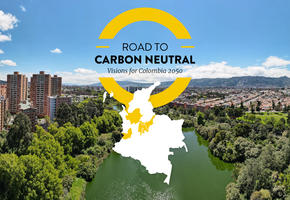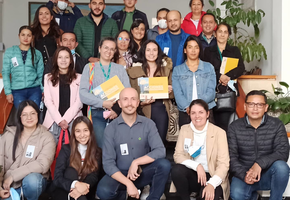Climate change cannot be solved by one actor. It needs collaboration.
The Paris Agreement itself “recognis[es] the importance of engagements of all levels of government and various actors”. Each stakeholder group offers a unique perspective, skillset, and responsibility. So, to develop effective, long-term climate solutions it is essential for governments to engage with a wide variety of actors.
The Road to Carbon Neutral project, supported through the UK PACT in Colombia programme, has been a shining example of this. Five Colombian departments – Antioquia, Atlántico, Boyacá, Cundinamarca, and Valle del Cauca – have developed their own decarbonisation pathway visions, across the energy and transport sectors.
A pathway is a transformational process that aims to reduce emissions in the long-term. In practice, it provides a flexible and tailored approach to reach net zero emissions. These decarbonisation pathway visions will shape each department’s short, medium, and long-term targets for their energy and transport sectors, and importantly support Colombia’s long-term goal to be carbon neutral by 2050.
Innovating through engagement activities
Stakeholder engagement is vital to develop a decarbonisation pathway vision. The approach used in this project was flexible - tailored to the needs of each stakeholder group. This helped to empower government officials, entrepreneurs, journalists, and civil society from across local territories in Colombia.
For example, to identify priorities across the transport and energy sectors, the project produced a Catalogue of Decarbonisation Actions in Energy and Transport. The catalogue is designed to be simple and accessible. It provides a clear and comprehensive list of actions that departments can choose to include in their pathway to reduce greenhouse gas emissions.
The catalogue has allowed stakeholders, from the public and private sectors, academia, and civil society, to engage with decarbonisation actions and align their activities to Colombia’s long-term national policy. The project team worked closely with the Ministry of Environment and Sustainable Development to build this policy alignment and bridge the gap between national and state level action.
Prioritising climate actions
Having shared with stakeholders the policy actions that can drive down emissions, the project team then worked closely with individual departments to prioritise a set of specific actions for each.
This included developing a Decarbonisation Actions Prioritisation Tool, to help states make informed decisions and prioritise decarbonisation actions across the short, medium, and long-term.
The tool uses two criteria:
- The level of readiness – to determine the level of knowledge, tools, and experience.
- The capacity of the department – to implement an action.
To determine the level of readiness the tool used three indicators:
- Availability of policy and / or a regulatory framework to support the measure, both at a national and subnational level.
- Availability of funding sources or incentives to promote the measure.
- Return of the investment which responds to the profitability of the projects associated with the measure.
To determine the capacity of the department the tool used three further indicators:
- GHG mitigation potential
- Positive impacts on the environment
- Positive impacts on quality of life
This prioritisation tool allowed departments to identify the specific policy actions that they could use to develop and structure their decarbonisation vision.
Using this tool has helped to enhance the capacity of the departments. It has allowed them to make informed decisions to reduce their carbon footprint, and now provides departments with the tools to implement additional long-term actions.



